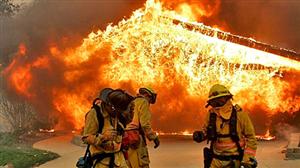The Insurance Review - December 2007
FIRE WAS EVERYWHERE
By Roland L. Enz - President, California
Plus Insurance Service, Inc.
A million here and a million there can add up to real money in a hurry. The fire storm of 2007, California’s worst accumulation of forest fires, consuming over 503,322 acres, created a loss estimated to be in excess of 1.6 billion dollars. Where will the money for rebuilding come from? The majority of the property loss will be covered by insurance. Over a million people were safely evacuated, and much to the amazement of all, only a few lives were lost in the event.
The entire state pulled together and showed the nation how a major catastrophe is handled and what us Californians are really made of. But don’t compare this tragedy with Hurricane Katrina, where over 41 billion dollars in property was lost. With any event of this magnitude there are always nay-sayers, or in the bigger picture, politicians and talking heads taking pot shots at the system and the administration. The system worked and all of the resources available were put into action, battling an enemy of horrific proportion. Loss was not confined to one Southern California area – over 16 separate fires were burning simultaneously, many of them merging. From the desert to the sea, and from Mexico to Malibu, Southern California was ablaze.
In 2003, fire swept through San Diego’s North County, destroying 3,500 homes. The total number of homes destroyed in the 2007 fires is estimated at 3,000 (this does not account for business property and loss to infrastructure). This is the second time in four years that San Diego County has been hit hard.
In computing any monetary loss in such an event, you have to include not only structures and contents, but loss to the infrastructure, such as streets, parks and utilities. The loss of revenue from business and commerce is a residual loss, which is compounded as it impacts the larger business and residential areas around it. Ancillary costs include temporary housing, subsistence and lost revenue costs – all or most of which will be absorbed by those affected directly. I was shocked to see so many people that were interviewed on the news that did not have insurance – and many of them had new homes. The areas that were affected were mostly medium to upper income. There should be no excuse to be uninsured. Other areas of loss such as infrastructure and utilities will be absorbed by either the tax payer or the rate payer. What did fighting the fires cost? Just a quick calculation off of the internet put the fire fighting cost at around 68 million dollars or more.
The loss to the insurance industry was large but in no way unmanageable. Insurance and the concept of insurance is quite simple. Shared risk through the premium developed by the policy holders, assigning their intended loss, by contract, to an insurance company. Legalized gambling by the insurance industry; they are betting that you will not have a loss, and you are betting that you could. The insurance industry is very savvy on calculating loss. They have teams of mathematical minds, called actuaries, figuring and considering future loss. Add to this sophisticated computer software programs, and the insurance industry is amazingly accurate on computing loss and future loss.
Premium is developed with that future loss in mind. The concept is to take the loss/reserve to include expenses, divided by the number of participants in a given category creating premium. Everyone shares in the loss. But in the bigger picture, insurance companies have to be socially conscious, maintaining adequate reserves for future loss and maintaining revenue for operations and profit. In any catastrophe, the event will impact all of us through the increase in premiums, taxes and subscribed services. Overall, the government’s share will be small compared to the private sector.
The insurance industry is interconnected through a web of companies, subsidiaries and reinsurance companies. An event such as this will impact each and every insurance company responding to the loss, as well as the industry as a whole. Some companies have stopped writing certain classes of business in California, while others are making noise about pulling out of the state completely. But in the final analysis, California is the largest insurance premium state in the nation, and the industry can not ignore the revenue that it produces.
The insurance industry is healthy, loss reserves seem to be adequate and loss ratios have been acceptable. These fires dealt the insurance industry a heavy blow, but one they could withstand. But brace yourself for repercussions, because there will be some. If you have any insurance-related comments or questions, please feel free to contact me through California Plus Insurance Service in Modesto, California at 1-800-699-7101.
Copyright
© 2007 10-4 Magazine and Tenfourmagazine.com
PO Box 7377 Huntington Beach, CA, 92615 tel. (714) 378-9990

